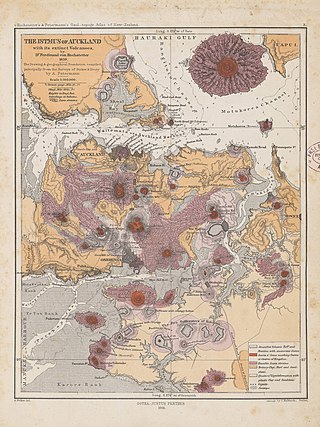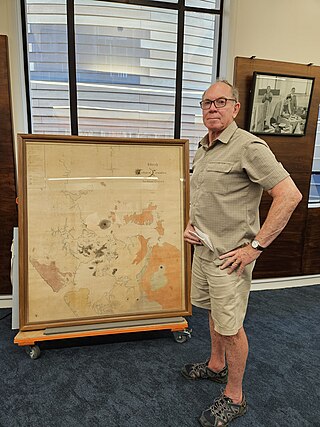
The Silurian is a geologic period and system spanning 24.6 million years from the end of the Ordovician Period, at 443.8 million years ago (Mya), to the beginning of the Devonian Period, 419.2 Mya. The Silurian is the shortest period of the Paleozoic Era. As with other geologic periods, the rock beds that define the period's start and end are well identified, but the exact dates are uncertain by a few million years. The base of the Silurian is set at a series of major Ordovician–Silurian extinction events when up to 60% of marine genera were wiped out.

A Fossil-Lagerstätte is a sedimentary deposit that exhibits extraordinary fossils with exceptional preservation—sometimes including preserved soft tissues. These formations may have resulted from carcass burial in an anoxic environment with minimal bacteria, thus delaying the decomposition of both gross and fine biological features until long after a durable impression was created in the surrounding matrix. Fossil-Lagerstätten span geological time from the Neoproterozoic era to the present.

The Auckland volcanic field is an area of monogenetic volcanoes covered by much of the metropolitan area of Auckland, New Zealand's largest city, located in the North Island. The approximately 53 volcanoes in the field have produced a diverse array of maars, tuff rings, scoria cones, and lava flows. With the exception of Rangitoto, no volcano has erupted more than once, but the other eruptions lasted for various periods ranging from a few weeks to several years. Rangitoto erupted several times and recently twice; in an eruption that occurred about 600 years ago, followed by a second eruption approximately 50 years later. The field is fuelled entirely by basaltic magma, unlike the explosive subduction-driven volcanism in the central North Island, such as at Mount Ruapehu and Lake Taupō.

The late Paleozoic icehouse, also known as the Late Paleozoic Ice Age (LPIA) and formerly known as the Karoo ice age, was an ice age that began in the Late Devonian and ended in the Late Permian, occurring from 360 to 255 million years ago (Mya), and large land-based ice-sheets were then present on Earth's surface. It was the second major icehouse period of the Phanerozoic.
Mount Tyndall is a mountain that is part of the Tyndall Range, a spur off the West Coast Range, located in the Western region of Tasmania, Australia.

The Lystrosaurus Assemblage Zone is a tetrapod assemblage zone or biozone which correlates to the upper Adelaide and lower Tarkastad Subgroups of the Beaufort Group, a fossiliferous and geologically important geological Group of the Karoo Supergroup in South Africa. This biozone has outcrops in the south central Eastern Cape and in the southern and northeastern Free State. The Lystrosaurus Assemblage Zone is one of eight biozones found in the Beaufort Group, and is considered to be Early Triassic in age.

A zooid or zoöid is a single animal that is part of a colonial animal. This lifestyle has been adopted by animals from separate unrelated taxa. Zooids are multicellular; their structure is similar to that of other solitary animals. The zooids can either be directly connected by tissue or share a common exoskeleton. The colonial organism as a whole is called a zoon, plural zoa.

The geology of New Zealand is noted for its volcanic activity, earthquakes and geothermal areas because of its position on the boundary of the Australian Plate and Pacific Plates. New Zealand is part of Zealandia, a microcontinent nearly half the size of Australia that broke away from the Gondwanan supercontinent about 83 million years ago. New Zealand's early separation from other landmasses and subsequent evolution have created a unique fossil record and modern ecology.

Kathleen Ann Campbell is an American-born New Zealand geology and astrobiology academic. She is currently a full professor at the University of Auckland. Her work is broadly centred in the topic of paleoecology and how ancient organisms interacted with their environment and whether they were capable of surviving under extremely hard conditions. Much of her research carries wide-ranged associations with questions about the origin of life and the possibility of life on Mars. She graduated from the University of Southern California and she is currently a full professor at the University of Auckland.
Richard Hugh Sibson is a New Zealand structural geologist and emeritus professor at the University of Otago, who has received numerous honors and awards for his work in the field of earthquake research. He has caused a 'fundamental shift' in the interpretation of the relationship between earthquakes and fault zone geology and on the origin of fault-hosted mineral deposits.
The Takatika Grit is a geologic formation in Chatham Islands, New Zealand. It preserves fossils dating back to the Paleocene period, although it also preserves disturbed and re-worked Maastrichtian and Campanian microfossils and tetrapod fossils. A 2017 study found that it dated to late Early to Mid Paleocene on the basis of dinoflagellates. It has been subdivided into two informal units, a lower phosphatic unit containing bones and nodular phosphatic layers, and an upper unit with abundant sponge remains and siliceous microfossils.
Gwyneth Alva Challis, known as Alva, was a Welsh-born New Zealand geologist who discovered the mineral Wairauite, and pioneered the use of x-rays for mineral investigation in New Zealand.

Bruce William Hayward is a New Zealand geologist, marine ecologist, and author. He is known as a leading expert on living and fossil foraminifera.

Sonja Lee Macfarlane (née Bateman) is a New Zealand education academic and an associate professor at the University of Canterbury. Macfarlane specialises in the development of cultural awareness in the New Zealand education system.
Carol Anne Mutch, also known by the nickname Dr Disaster, is a New Zealand academic, and is Professor of Critical Studies in Education at the University of Auckland, specialising in disaster management and recovery in educational settings, and the role of schools during crises.
Catherine Mary Bishop is a New Zealand academic materials scientist, and is a full professor at the University of Canterbury, specialising in materials modelling of metallic and ceramic materials.
Catherine Ann Moran is a Canadian–New Zealand academic, and is a full professor at the University of Canterbury, specialising in memory and cognition, and language learning. She is especially interested in how head injuries affected the development and processing of language.
Julie Varina Rowland is a New Zealand structural geologist, and is a full professor at the University of Auckland, specialising in tectonic-magmatic-hydrologic interactions, particularly in rift systems. In 2015 she became the first woman to win the Geoscience Society of New Zealand's McKay Hammer Award.

Christine M. Kenney is a New Zealand sociologist, and is a Professor of Disaster Risk Reduction at Massey University. She is the first Māori woman to lead a UN international science caucus.
Kaye Jennifer Thorn is a New Zealand management and human resources academic, and is a full professor at Massey University. Thorn specialises in career progression, studying issues such as mobility, gender and hybrid work.










